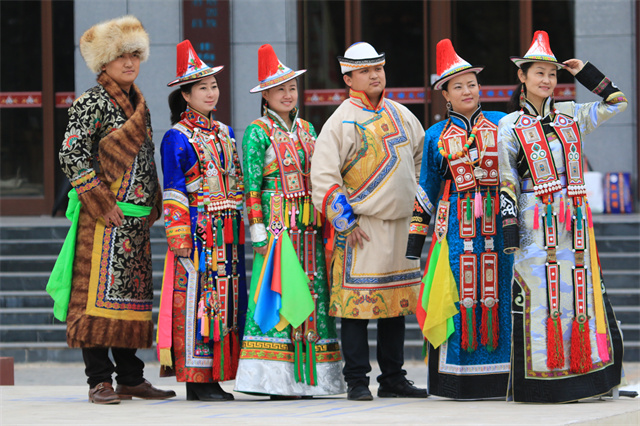Intangible cultural heritage becomes industrial subject
A Yugur ethnic costume workshop established over three years ago has seen its brand enjoy more and more recognition. Holding 50 appearance patents, seven trademarks, and one copyright, the workshop has trained more than 1,000 people, contributing to local rural revitalization.

A group of Yugur people dressed in traditional clothing. [Photo/IC]
The Yugur were once nomads who lived by herding. Most of the current population of about 10,000 live in Sunnan Yugur autonomous county, Zhangye, Gansu province.
Their traditional costume feature embroidery and accessories, such as beads and shells, with tens of thousands of beads beingstrung and then sewn onto each item. The styles differ according to the subgroup and complex rules must be followed.
Traditionally, unmarried Yugur girls wear decorative head ware, that is, a long red cloth belt with colored coral beads and jade on the lower edge to form a curtain. Yugur dresses for married women feature a high collar and a hat with tassels. Each Yugur woman has her own traditional dress that was made bit by bit when she was still a child.

Yugur people display their traditional clothing. [Photo/IC]
The workshop invites experts, intangible cultural heritage inheritors, and cultural and historical consultants to conduct research and development based on market demand.
They drew inspiration from ancient documents and cultural relics, such as the Dunhuang Mogao murals, the Bezeklik Thousand Buddha Caves, and the West Temple at Beting in Jimsar County, and designed colorful lucky fish money bags, embroidered sachets, cloaks and ancient Uighur clothes.
Elements of camel caravan culture of the Silk Road were also added to key cases, pendants and other small objects.
In addition, the workshop rolled out a series of health products, including Salma hot compress salt bags according to handed down poems and Uighur scrolls that record historic tourism experiences.

Women learn to make Yugur traditional clothing. [Photo/IC]
The workshop has constructed exhibition areas and DIY experience areas in several locations. They focus on displaying existing products and showcasing the culture of Yugur people and their ancestors, Uighur people.
Cooperation agreements have been signed with Zhangye Danxia Scenic Area, Kangle Grassland Scenic Spot, and Mati Temple Scenic Spot, putting more than 15,000 new products into the market.
-
As AI encounters Dunhuang's art, the ancient caisson ceiling bridges centuries to the present.
View all stories

 Gansu thrives from green development
Gansu thrives from green development  >
>